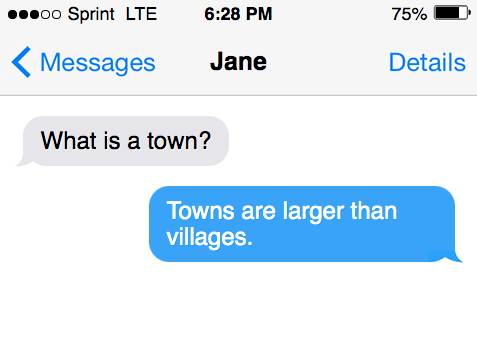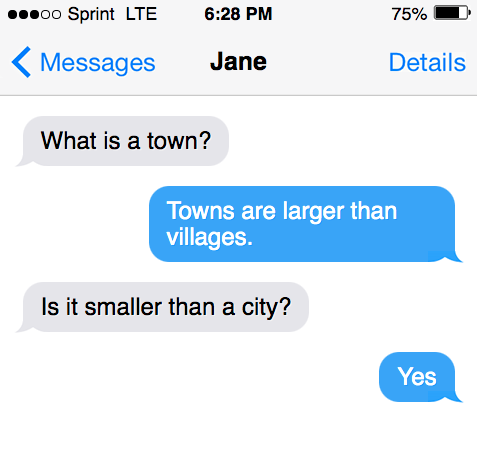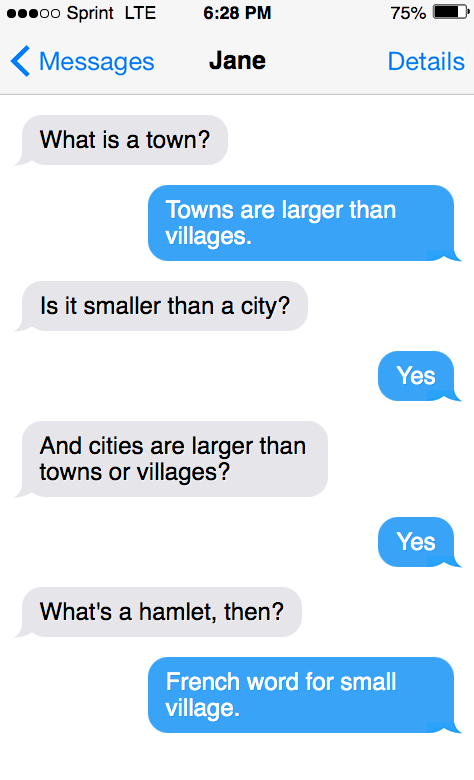What’s the difference between a village vs. town? Are cities the same as towns? Is it a population size, city status, geography, or government question?
Continue reading this lesson to learn the key differences…
What’s the difference between a city, town, and village?
Towns, townships, cities, and villages are names that classify different places based on various markers, like population size, geography, land size, economic resources, industry, and resident services.
What’s the difference: is it a town, village, or city?
Answer: it depends on the country and place and their specific definition of the term.
Countries, states, and even cities can determine what comprises a town, village, or city on their own.
For example: in Canada, the legal definition of a city or town varies based on the province or territory. The United States works similarly, though they use the term ‘state’ rather than ‘province’ or ‘territory,’ which are Canadian terms.
What’s a town?
Towns are urban areas that are smaller than cities, and generally larger than villages. These sources each describe what comprises a town:
The online dictionary defines a town as:
“A a thickly populated area, usually smaller than a city and larger than a village, having fixed boundaries and certain local powers of government.”
On Wikipedia, a town is:
“A human settlement … that is larger than villages and smaller than cities … the criteria to distinguish between them vary considerably in different parts of the world.”
Merriam-Webster‘s definition is “A compactly settled area usually larger than a village but smaller than a city.”

Broadly speaking, then, towns have three distinguishing features:
- Towns are larger than villages;
- Smaller than cities;
- And are densely populated areas.
This answers a few questions, but it raises further questions as well: How big does a village have to be for it to be considered a village? What gives a city its city status? As Wikipedia says, it depends on the consulted sources, and the country’s own understanding and definitions of the term.
Even in the United States, what’s defined as a town varies depending on the state. Small towns in the United States are sometimes called townships, depending on the state.
Not all states use the term township; however, Township government is instated in Indiana, Kansas, Michigan, Missouri, Minnesota, New Jersey, North Dakota, Ohio, Pennsylvania, South Dakota, and Wisconsin (in Wisconsin, known as towns).
Take a look at how these states differentiate between towns, townships, boroughs, cities, and counties:
- Alabama recognizes legal differences between a town and a city based on population, “A municipality with a population of 2,000 or more [inhabitants] is a city, while less than 2,000 is a town.” (Code of Alabama 1975, Section 11-40-6)
- There is no legal difference between a town and a city in California, and the two terms can be used interchangeably. (see Cal. Govt. Code Secs. 34500–34504). There are, however, two types of city statuses recognized in California: charter cities and general rule or general law cities. For the most part, charter cities determine their own local government; whereas general law cities adopt the state’s existing laws and regulations as their government structure. California has 482 incorporated cities and 22 towns.
- In Louisiana, towns are defined as a municipal governing body with a population between 1,001-4,999 people.
- Other states, like Maryland and Arizona, use the two terms ‘towns’ and ‘cities’ interchangeably.
- In Hawaii, the entire island is incorporated as a single town or a single city under the City and County of Honolulu.
- In Nevada, a town or township have a kind of government though they are not considered incorporated municipalities.
- In the six New England states (Connecticut, Maine, Massachusetts, New Hampshire, Rhode Island and Vermont,) towns hold similar or the same functions and powers as a county would in other states.
In the United States, no one thing or trait distinguishes a town from a city or village. Each state is free to differentiate between them on whichever terms suit them best.
This is because of states’ rights, ratified in the Constitution by the 10th amendment: “Any power not explicitly granted to the federal government lies solely in the states.”
As such, defining what constitutes a city, town, or village is outside of federal rule or jurisdiction, so states are free to set their own terms for what they consider to be a town or township, village, and city.
Speaking in broad terms, what typically distinguishes a town from a city is either the size of the population, or the form of local government that presides in the given area.

Bonus Fact!
Here’s a fun bonus fact to whip out at a party or social event!
On the south coast of Finland, there’s a place called Tapiola that was constructed in the 1950s and 1960s, and is dubbed a ‘garden city.’ The garden city movement was a 20th century urban planning movement which sought to combine elements of village life and the countryside with city life.
Other garden cities that were inspired by the movement includes Brentham Garden Suburb near London, and Welwyn Garden City near London.
What’s a village?
Villages are “clustered human settlements” (Wikipedia) or separate settlements that are smaller than towns but larger than hamlets. Villages typically have a population range between a couple hundred to a few thousand.
Villages are primarily in rural areas or the countryside. They’re located outside towns and cities, have a lower population density, and are generally small communities.

The photo shown above taken by National Geographic shows a village in the Bengali region of India, which is primarily a rural area that extends through northeastern India to western Bangladesh.
One main difference between a town and a village is that villages tend to rely on agriculture and farming as the primary economic source. Villages are in the country or more rural areas with farmland and broader spaces.
What’s a city?
Cities are larger human settlements. They are considered larger than towns and villages in both population, size, and degree of importance.
Many places in the world assign cities a special symbolic status known as city status. This status gives cities various legal distinctions and/or freedoms.
In the United States, most states require a minimum number of inhabitants to qualify as a city. The minimum number of citizens to qualify as a city in the US typically ranges between 1,500-5,000 inhabitants.
The majority of cities in the US are incorporated municipalities, meaning they have a corporate status and set local government.
Cities are generally urban communities or urban areas (also referred to as urbanism).

What do these terms mean in other parts of the world?
In England, the word hamlet (not the tragic play by William Shakespeare, though spelled and pronounced the same) is the term for a community that’s smaller than a village and is a type of settlement with no central meeting point or place of worship (like a cathedral).
During the 1500s, a town in England was given the title of being a city by the English Crown only if it had a cathedral within its boundaries. The connection between being considered a legitimate city and having a cathedral was established by Henry VIII.
The word ‘hamlet’ comes from the old French term for hamelet, meaning small settlements or small villages.
Origin of the word town
The word town comes from the Old English tun, meaning “enclosure, garden, field, yard; farm, manor; homestead, dwelling house, mansion.”
Later, the word evolved to mean “group of houses, village, farm” from the Proto-Germanic tunaz, meaning “fortified place.”
Origin of the word village
The word village derives from the French word vilage, meaning “houses and other buildings in a group.”
The French word vilage originated from the Latin villaticum, meaning farmstead and outbuildings, such as a shed or barn.
Origin of the word city
City derives from the Latin root word, civitas, meaning ‘citizenship,’ or ‘community member.’

Examples of sentences using village, town, or city
- “The town is just a picturesque, convenient, middle-sized town an hour from London.” Rachel Cusk, The Bradshaw Variations, (2009)
- “I would love to walk or bike around the city to do some sightseeing.”
- “The soul of India lives in its villages,” said Mahatma Gandhi.
- “Village residents get to enjoy the fresh air, open spaces and green fields that surround them each day.”
- “The City of York in the UK is still home to numerous historical hamlets, cottages and all kinds of tourist attractions for people to enjoy.”
- “While larger towns and cities usually have more facilities, shops, and services, most would still agree that rural living has plenty of advantages that cannot be captured by city life.”
- “Since 2018 census, the United States has 19,495 incorporated cities, towns and villages.” (World Population Review.)
In Review
Generally speaking, the terms town, village, and city are all classifications for different places. To understand how various countries, states and cities use these terms, it’s necessary to see how they define it according to their legislation and jurisdiction.
For the most part, cities are the largest of the three. They are the most densely populated and have the most extensive land mass.
Cities usually have various neighborhoods or boroughs. Boroughs are a municipality and units of local government that are only recognized in the following six states:
- Connecticut, (there are 8 boroughs in Connecticut: the Woodmont Association in Milford, Bantam and Litchfield in Litchfield, Danielson in Killingly, Fenwick in Old Saybrook, Jewett City in Griswold, Newtown in Newtown, and Stonington in Stonington)
- New Jersey (the state of New Jersey is comprised of 253 boroughs, 21 counties, and 564 municipalities)
- Pennsylvania, (there are 956 boroughs and 56 cities in Pennsylvania)
- New York, (the entire state of New York is incorporated: residents that do not live in cities, boroughs or Indian reservations are, by default, residing in towns. New York comprises five boroughs: The Bronx, Brooklyn, Manhattan, Queen’s, and Staten Island)
- Virginia, (Virginia has seven boroughs: Bayside, Blackwater, Kempsville, Lynnhaven, Princess Anne, Pungo, and Virginia Beach)
- Alaska (Alaska is divided into 19 boroughs and one unorganized borough. Only “Alaska and Louisiana are do not call their first-order administrative subdivisions counties (Louisiana uses parishes instead).[1]” (Wikipedia)
- Wisconsin (there are 94 municipalities in Wisconsin)
Glossary
- Term town: https://www.dictionary.com/browse/town
- Term city: https://www.merriam-webster.com/dictionary/city
- Village definition: https://www.merriam-webster.com/dictionary/village
Sources
- Origin of town
- Boroughs in the United States
- City word origin
- Village term origin
- Village etymologyNational Geographic, Bengali Village
Inside this article
Fact checked:
Content is rigorously reviewed by a team of qualified and experienced fact checkers. Fact checkers review articles for factual accuracy, relevance, and timeliness. Learn more.
Core lessons
Glossary
- Abstract Noun
- Accusative Case
- Anecdote
- Antonym
- Active Sentence
- Adverb
- Adjective
- Allegory
- Alliteration
- Adjective Clause
- Adjective Phrase
- Ampersand
- Anastrophe
- Adverbial Clause
- Appositive Phrase
- Clause
- Compound Adjective
- Complex Sentence
- Compound Words
- Compound Predicate
- Common Noun
- Comparative Adjective
- Comparative and Superlative
- Compound Noun
- Compound Subject
- Compound Sentence
- Copular Verb
- Collective Noun
- Colloquialism
- Conciseness
- Consonance
- Conditional
- Concrete Noun
- Conjunction
- Conjugation
- Conditional Sentence
- Comma Splice
- Correlative Conjunction
- Coordinating Conjunction
- Coordinate Adjective
- Cumulative Adjective
- Dative Case
- Determiner
- Declarative Sentence
- Declarative Statement
- Direct Object Pronoun
- Direct Object
- Diction
- Diphthong
- Dangling Modifier
- Demonstrative Pronoun
- Demonstrative Adjective
- Direct Characterization
- Definite Article
- Doublespeak
- False Dilemma Fallacy
- Future Perfect Progressive
- Future Simple
- Future Perfect Continuous
- Future Perfect
- First Conditional
- Irregular Adjective
- Irregular Verb
- Imperative Sentence
- Indefinite Article
- Intransitive Verb
- Introductory Phrase
- Indefinite Pronoun
- Indirect Characterization
- Interrogative Sentence
- Intensive Pronoun
- Inanimate Object
- Indefinite Tense
- Infinitive Phrase
- Interjection
- Intensifier
- Infinitive
- Indicative Mood
- Participle
- Parallelism
- Prepositional Phrase
- Past Simple Tense
- Past Continuous Tense
- Past Perfect Tense
- Past Progressive Tense
- Present Simple Tense
- Present Perfect Tense
- Personal Pronoun
- Personification
- Persuasive Writing
- Parallel Structure
- Phrasal Verb
- Predicate Adjective
- Predicate Nominative
- Phonetic Language
- Plural Noun
- Punctuation
- Punctuation Marks
- Preposition
- Preposition of Place
- Parts of Speech
- Possessive Adjective
- Possessive Determiner
- Possessive Case
- Possessive Noun
- Proper Adjective
- Proper Noun
- Present Participle
- Prefix
- Predicate



